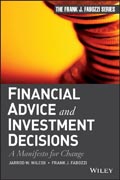
Financial Advice and Investment Decisions
Wilcox, Jarrod W.
CFA, Fabozzi, Frank J.
A practical guide to adapting financial advice and investing to a post crisis world There?s no room for business as usual in today?s investment management environment. Following the recent financial crisis, both retail and institutional investors are searching for new ways to oversee investment portfolios. How do you combine growth with a focus on wealth preservation? This book offers you a fresh perspective on the changes in tools and strategies needed to effectively achieve this goal. Financial Advice and Investment Decisions provides today?s investment professionals with the conceptual framework and practical tools they need to successfully invest in and manage an investment portfolio with wealth preservation as a key concern. While there are many qualitative discussions, the authors present strong quantitative theory and practice in the form of small conceptual models, simulation, and empirical research. A comprehensive guide to properly managing investments with a focus on matching security and growth goals with the needs of the investor Blends insights gleaned from portfolio management practices used prior to the market mayhem of 2007–2009 with cutting–edge academic and professional investment research Includes innovative and wide–ranging treatment of subjects such as augmented balance sheets, the efficiency of markets, saving, spending, and investing habits, and dealing with uncertainty Description of opportunities for improving the investing environment The recent financial crisis has opened our eyes to the need for improving the way we invest. This book will put you in a better position to excel in this new economic environment. INDICE: Preface xi Acknowledgments xiii About the Authors CHAPTER 1 Why Do We Need Better Financial Advice? 1 The Individual 2 Organizational Influences 4 The Rest of the Story 10 CHAPTER 2 The Evidence Is Compelling 13 Financial Planning 13 Your Most Important Investment Decision 14 Option Payoffs are Not Simple 18 After–Tax Payoffs are Not Simple 20 Our Primitive Brains and Monkey See, Monkey Do 21 Others’ Agendas and the Perils of the Ivory Tower 22 CHAPTER 3 The Extended Balance Sheet Approach to Financial Planning 25 The Simplest Model 25 The Stochastic Dynamic Programming Alternative 29 The Mental Accounting Alternative 30 The Extended Balance Sheet 31 A Financial Planning System 37 CHAPTER 4 Properties of Mostly Efficient Markets 43 Multi–Agent Emergent Behavior 44 Why Security Returns are Difficult to Predict 46 Markets Bubble and Crash 48 Investment Implications of Market Characteristics 57 CHAPTER 5 Growing Discretionary Wealth 59 The Discretionary Wealth Approach 59 Elements of the Approach 60 Appropriate Markowitz Risk Aversion 73 CHAPTER 6 Coping with Uncertain Knowledge 79 Interpretation of Probability 80 Bayesian Probability Fundamentals 81 Resisting Forecasting Overconfidence 87 Making Estimates More Robust to Extreme Observations 95 Taking Context into Account 99 Making Better Use of Information in Decisions 102 CHAPTER 7 Controlling Investing Behavioral Biases 105 Facing Up to Complexity 106 Promoting Independent Thinking 115 Controlling Organizational Biases 117 CHAPTER 8 Tax Efficient Investing 121 Context 121 Taxes that Affect Investment Returns 123 General Principles of After–Tax Investing 131 Measurement of After–Tax Performance and Benchmarks 140 CHAPTER 9 Matching Investment Vehicles to Needs 143 Revisiting Risk Aversion 144 Taxes Again 146 Diversification 148 Higher Moments 150 Implementation 155 CHAPTER 10 Active vs. Passive Strategies 167 Pricing Efficiency and the Active–Passive Debate 169 CHAPTER 11 Performance Measurement 185 Relating Measurement to Purpose 185 Spending Control 187 Measurement for Individual Passive Investing 190 Performance Reporting for Active Investors 197 Delegating Your Investments Based on Measurements 208 Measuring vs. Evaluating Performance 213 CHAPTER 12 Organizational Investing 217 Representative Investing Organizations 217 Delegating Superior Investing Results 232 Motivating Organizational Benefits 241 CHAPTER 13 Financial Advice and Society 243 Social Ideals and Financial Problem Symptoms 245 Redesigning Society with Better Financial Advice 248 And in Conclusion… 274 APPENDIX A Traditional Asset Classes and Alternative Assets 275 Asset Class Defined 275 Common Stock Asset Classes 276 Real Estate 278 Alternative Assets 280 APPENDIX B Bond Features, Yield Measures, and Risks 287 Features of Bonds 287 Yield Measures and their Limitations 289 Call and Prepayment Risk 296 Credit Risk 297 APPENDIX C Probability Distributions Commonly Used in Investment Management 301 Normal Distribution 301 Student’s t–Distribution 303 Stable Distributions and Stable Paretian Distributions 303 APPENDIX D Useful Financial Planning Formulas 305 Working with Present Values 305 Determining the Required Savings–to–Income Ratio 305 Taking Initial Investments and Needed Retirement Income Reduction into Account 306 Investment Return Mean and Variance 307 Deriving an Estimate of Discretionary Wealth Growth Rate 307 Estimating Appropriate Expected Return for Compounding 308 References 311 Index 321
- ISBN: 978-0-470-64712-7
- Editorial: John Wiley & Sons
- Encuadernacion: Cartoné
- Páginas: 352
- Fecha Publicación: 20/11/2013
- Nº Volúmenes: 1
- Idioma: Inglés
